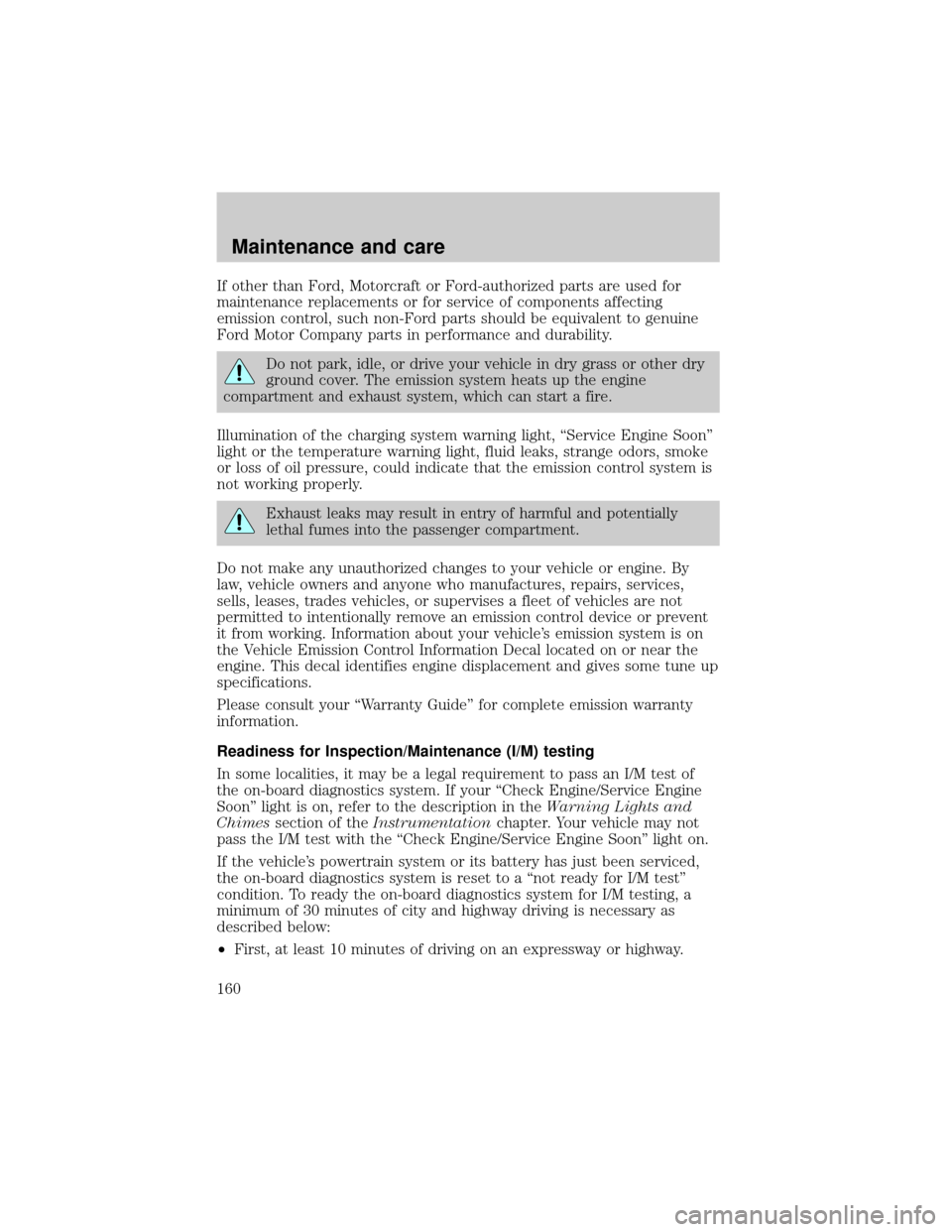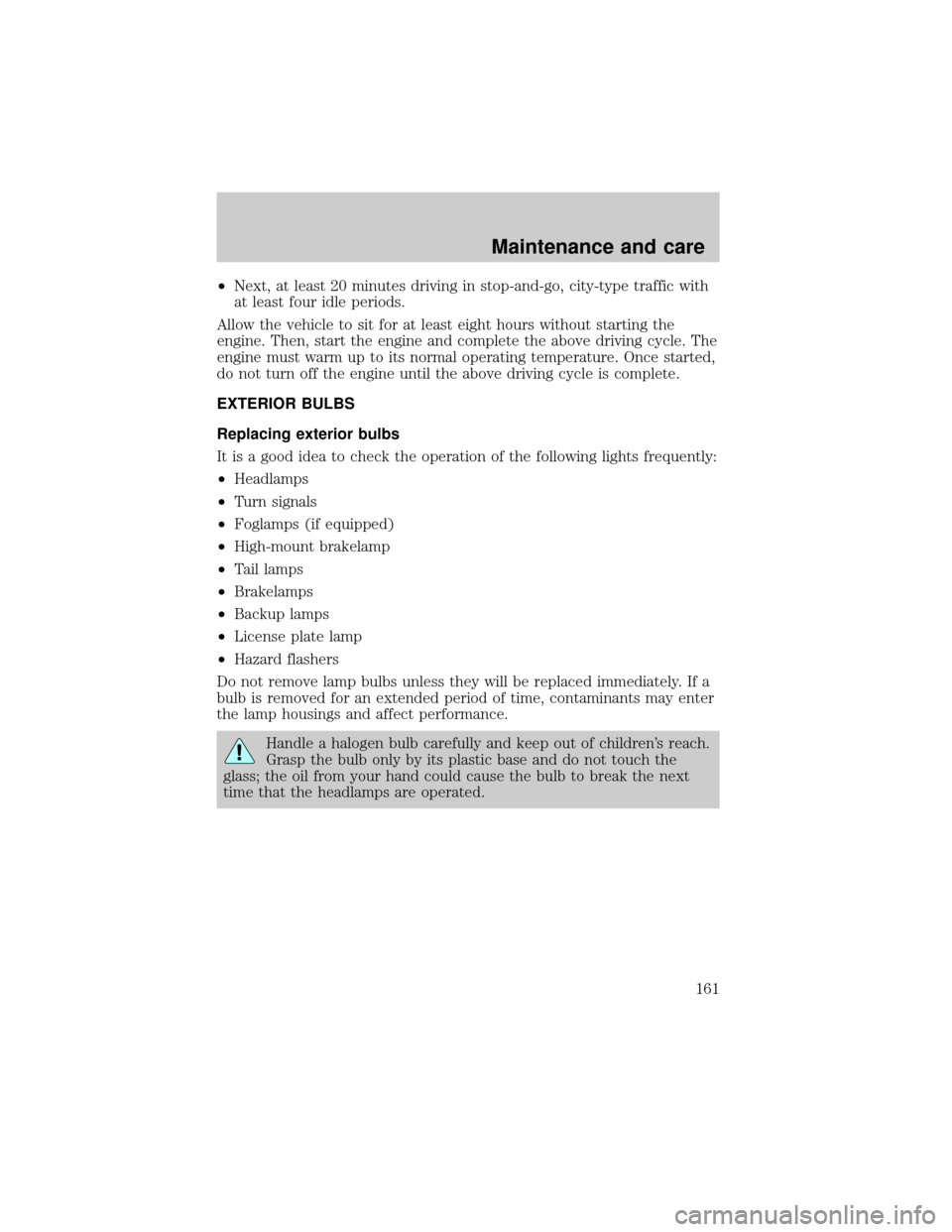oil temperature FORD ESCORT 1999 7.G Owners Manual
[x] Cancel search | Manufacturer: FORD, Model Year: 1999, Model line: ESCORT, Model: FORD ESCORT 1999 7.GPages: 200, PDF Size: 1.37 MB
Page 160 of 200

If other than Ford, Motorcraft or Ford-authorized parts are used for
maintenance replacements or for service of components affecting
emission control, such non-Ford parts should be equivalent to genuine
Ford Motor Company parts in performance and durability.
Do not park, idle, or drive your vehicle in dry grass or other dry
ground cover. The emission system heats up the engine
compartment and exhaust system, which can start a fire.
Illumination of the charging system warning light, ªService Engine Soonº
light or the temperature warning light, fluid leaks, strange odors, smoke
or loss of oil pressure, could indicate that the emission control system is
not working properly.
Exhaust leaks may result in entry of harmful and potentially
lethal fumes into the passenger compartment.
Do not make any unauthorized changes to your vehicle or engine. By
law, vehicle owners and anyone who manufactures, repairs, services,
sells, leases, trades vehicles, or supervises a fleet of vehicles are not
permitted to intentionally remove an emission control device or prevent
it from working. Information about your vehicle's emission system is on
the Vehicle Emission Control Information Decal located on or near the
engine. This decal identifies engine displacement and gives some tune up
specifications.
Please consult your ªWarranty Guideº for complete emission warranty
information.
Readiness for Inspection/Maintenance (I/M) testing
In some localities, it may be a legal requirement to pass an I/M test of
the on-board diagnostics system. If your ªCheck Engine/Service Engine
Soonº light is on, refer to the description in theWarning Lights and
Chimessection of theInstrumentationchapter. Your vehicle may not
pass the I/M test with the ªCheck Engine/Service Engine Soonº light on.
If the vehicle's powertrain system or its battery has just been serviced,
the on-board diagnostics system is reset to a ªnot ready for I/M testº
condition. To ready the on-board diagnostics system for I/M testing, a
minimum of 30 minutes of city and highway driving is necessary as
described below:
²First, at least 10 minutes of driving on an expressway or highway.
Maintenance and care
160
Page 161 of 200

²Next, at least 20 minutes driving in stop-and-go, city-type traffic with
at least four idle periods.
Allow the vehicle to sit for at least eight hours without starting the
engine. Then, start the engine and complete the above driving cycle. The
engine must warm up to its normal operating temperature. Once started,
do not turn off the engine until the above driving cycle is complete.
EXTERIOR BULBS
Replacing exterior bulbs
It is a good idea to check the operation of the following lights frequently:
²Headlamps
²Turn signals
²Foglamps (if equipped)
²High-mount brakelamp
²Tail lamps
²Brakelamps
²Backup lamps
²License plate lamp
²Hazard flashers
Do not remove lamp bulbs unless they will be replaced immediately. If a
bulb is removed for an extended period of time, contaminants may enter
the lamp housings and affect performance.
Handle a halogen bulb carefully and keep out of children's reach.
Grasp the bulb only by its plastic base and do not touch the
glass; the oil from your hand could cause the bulb to break the next
time that the headlamps are operated.
Maintenance and care
161
Page 195 of 200

Getting the
service you need ....................183
Ordering additional
owner's literature ...................192
The Dispute Settlement
Board .......................................184
Defrost
rear window ..............................42
Dipstick
engine oil .................................130
Driving under special
conditions
through water .........................102
Emergencies, roadside
jump-starting ..........................117
Emission control system ..........159
Engine .................................176,177
check engine/
service engine soon light ...........7
coolant .....................................137
idle speed control ...................144
lubrication
specifications ...................175,176
refill capacities ........................174
service points ...................129,130
starting after a collision .........105
Engine block heater ...................87
Engine oil ..................................130
checking and adding .......130,132
dipstick ....................................130
filter, specifications .........133,174
recommendations ...................133
refill capacities .................130,174
specifications .....130,133,175,176
Exhaust fumes ............................87
Floor mats ...................................54
Fluid capacities .........................174
Foglamps .....................................44
Fuel ............................................152
calculating fuel economy .......156
cap ...........................................154
capacity ...................................174choosing the right fuel ...........154
comparisons with EPA fuel
economy estimates .................159
detergent in fuel .....................155
filling your vehicle
with fuel ....................152,154,156
filter, specifications .........156,174
fuel pump
shut-off switch ...................54,105
gauge .........................................12
improving fuel economy ........156
low fuel warning light ................7
octane rating .............155,176,177
quality ......................................155
running out of fuel .................155
safety information relating to
automotive fuels .....................152
Fuses ..........................................107
Gas cap (see Fuel cap) ............154
Gas mileage
(see Fuel economy) .................156
Gauges .........................................11
engine coolant
temperature gauge ...................12
fuel gauge ..................................12
odometer ...................................13
speedometer .............................13
tachometer ................................13
trip odometer ............................13
GAWR
(Gross Axle Weight Rating) .....100
definition .................................100
driving with a heavy load ......100
location ....................................100
GVWR (Gross
Vehicle Weight Rating) .............100
calculating ...............................100
definition .................................100
driving with a heavy load ......100
location ....................................100
Hazard flashers .........................105
Head restraints ...........................61
Index
195